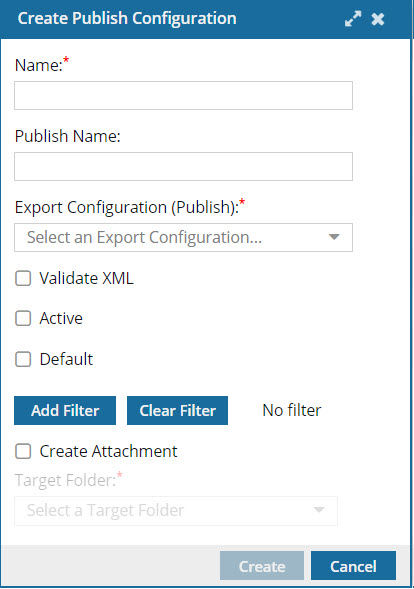A Publish Configuration lets you specify commonly used settings, such as the process to use to create the output (Export Configuration (Publish)), XML validation, if the configuration should be available to the user to select, and if it is the default choice when they open the Publish Component screen.
 The same settings in the Publish Configuration that an admin creates are also available to the user on the Publish component screen.
The same settings in the Publish Configuration that an admin creates are also available to the user on the Publish component screen.
- If the user selects different options on the Publish Component screen, their settings are used if they are in conflict with the Publish Configuration that an admin creates.
- If the user selects options on the Publish Component screen that don't conflict with the Publish Configuration that an admin creates, then both sets of options are used.
- Although you can specify the process used to create the output in Export Configuration (Publish), the user can also select it on the Publish Component screen.
- The user's configuration choice is used to create the output, even if it is in conflict with the Export Configuration (Publish) set in the Publish Configuration by an admin.
- Examples of Export Configuration (Publish) options can be:


To create a publishing configuration:
-
From the
 Administration menu, select Publish settings, and then select Publish Configuration Management.
Administration menu, select Publish settings, and then select Publish Configuration Management.
-
On the Publish Configuration Management tab, click Create.
-
In Name, enter a unique title for the configuration in 50 characters or less.
-
Optionally, you can enter a title for the deliverable in Publish Name using 100 characters or less. If you don't add a Publish Name, the component name is used at the time of publishing.
-
In Export Configuration (Publish), specify the process used to create output such as PDF or HTML.
-
If you want to verify that your XML code in your component is valid according to your framework at the time of publishing, select the Validate XML option.

By default this option is not selected.
-
If you want this configuration to be available to the user on the Publish Component screen in the Export Configuration (Publish) list, select Active.
-
If you want this configuration to be selected by default for users on the Publish Component screen in the Export Configuration (Publish) list, select Default.
-
If you've applied profiling attributes to content in the component you're publishing, you can use filters.
-
To choose the profiling attributes you want included in the publishing job, click Add Filter.
-
On the Filter profiling attributes tab, select the options you want to publish, and then click Select.
-
You see the profiling attributes you select on the Publish Component screen, listed after the Clear Filter button.
-
If you want to import the published deliverable back into Inspire automatically, select Create Attachment.
-
In Target Folder, select the location where you want the publish deliverable saved in Inspire.
 The file is saved as a binary and named using the following format: Publish-{ComponentName}-YYYY-MM-DD-HHHHMM.
The file is saved as a binary and named using the following format: Publish-{ComponentName}-YYYY-MM-DD-HHHHMM.
-
Click Create.
 Results:
Results:
- You see the new configuration on the Publish Configuration Management tab.
- Users don't need to log out and back in to see the new configuration on the Publish Component screen if you marked the new configuration as Active.
 The same settings in the Publish Configuration that an admin creates are also available to the user on the Publish component screen.
The same settings in the Publish Configuration that an admin creates are also available to the user on the Publish component screen.



 By default this option is not selected.
By default this option is not selected.
 Results:
Results: